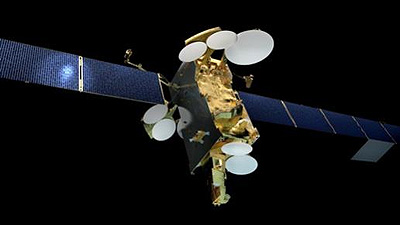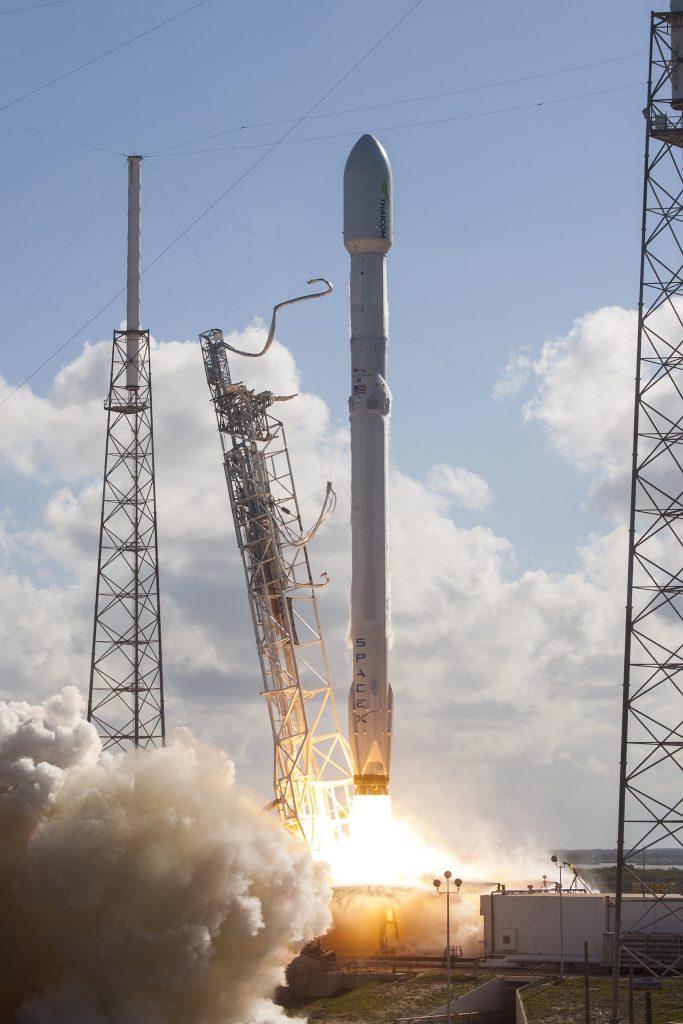SpaceX is targeting launch of the SES-12 satellite to a Geostationary Transfer Orbit (GTO) from Space Launch Complex 40 (SLC-40) at Cape Canaveral Air Force Station, Florida. The four-hour launch window opens on Monday, June 4 at 12:29 a.m. EDT, or 4:29 UTC. The satellite will be deployed approximately 32 minutes after liftoff. A four-hour backup launch window opens on Tuesday, June 5 at 12:29 a.m. EDT, or 4:29 UTC.
Falcon 9’s first stage for the SES-12 mission previously supported the OTV-5 mission from Launch Complex 39A in September 2017. SpaceX will not attempt to recover Falcon 9’s first stage after launch.
 |
|
Launch date:
|
June 4, 2018
Launch Window Opens:
|
12:29 a.m. EDT/4:29 UTC
Launch Window Closes:
|
4:29 a.m. EDT/8:29 UTC
Backup Launch Window:
|
Tuesday, June 5 (12:29 a.m. EDT/4:29 UTC)
Launch site:
|
Space Launch Complex 40 (SLC-40), Cape Canaveral Air Force Station, Florida
{colsp=2}
[highlight]L[eventtimer]2018-06-04 04:29:00;%c%%ddd%/%hh%:%mm%:%ss%[/eventtimer][/highlight]
Mission Patch
Launch coverage:
Payload:

SES 12 is a powerful geostationary communications satellite operating in Ku- and Ka-bands, which uses electric propulsion for initial orbit raising and all on-orbit manoeuvres.
Airbus Defence and Space, the world’s second largest space company, has been awarded a contract by SES in July 2014 to design and build a highly innovative high-performance telecommunications satellite.
The satellite will have a dual mission. It will replace the NSS-6 satellite in orbit, providing television broadcasting and telecom infrastructure services from one end of Asia to the other, with beams adapted to six areas of coverage. It will also have a flexible multi-beam processed payload for providing broadband services covering a large expanse from Africa to Russia, Japan and Australia.
SES-12 will be based on the highly reliable Eurostar E3000 platform from Airbus Defence and Space as an all new EOR (Electric Orbit Raising) version. This version uses only electric propulsion for initial orbit raising, with the reduction in mass enabling the satellite to be equipped with an exceptionally large payload.
SES-12 will operate in the Ku and Ka bands with a total of 76 active transponders, and will be equipped with eight antennas. The satellite also incorporates other state-of-the-art solutions, in particular multi-beam antennas linked to a digital signal processor that enables a multitude of basic spectral channels to be allocated to various beams in a completely flexible manner. It will have a launch weight of 5,300 kg and an electric power of 19 kW.
SES-12 was to launched in late 2017 on an Ariane-5ECA booster, and its electric propulsion system will enable it to reach its geostationary orbit in three to six months, depending on the type of launcher used. In August 2017, the launch providers for SES 12 and SES 14 were switched, putting SES 12 on a Falcon-9 v1.2(ex). Its nominal operational position will be 95° East and it has been designed to remain in service in orbit for more than 15 years.
Specifications
Type / Application:|
- Communication
Operator:|
- SES
Contractors:|
- Airbus Defence and Space
Equipment:|
- 68 active Ku-band transponders
- 8 Ka-band transponders
Configuration:|
Propulsion:|
- Fakel SPT140D propulsion unit
Power:|
- 2 deployable solar arrays
- Batteries
Lifetime:|
- 18 years
Mass:|
- 5383.85kg
Orbit:|
- GEO
- Insertion orbit: Super Synchronous GTO (294 x 58,000 km, ?°)
Launch Vehicle:
Falcon 9 FT represents an evolved version of SpaceX’s Falcon 9 v1.1 rocket incorporating a number of performance enhancements to enable the launch vehicle to lift heavy satellites to Geostationary Transfer Orbit while preserving the option of re-using the first stage. Operated by Space Exploration Technologies, the rocket represents the third evolutionary stage of the Falcon 9. The Falcon 9 Full Thrust (FT) vehicle is also known as ‘Falcon 9 Upgrade,’ ‘Enhanced Falcon 9,’ ‘Full Performance Falcon 9’ and ‘Falcon v1.2.’
The Falcon 9 FT launch vehicle is based on the Falcon 9 v1.1 (F9R) which in turn built on the original Falcon 9, retrospectively known as the v1.0 version of the rocket. Falcon 9 v1.0 was inaugurated in 2010 and flew successfully five times until 2013 when it was succeeded by the v1.1 version of the launcher. Falcon 9 v1.1 is retired after 15 missions, one of which was a failure. The v1.1 version itself was subject to a stepwise evolution, notably the implementation of reusability technologies on its first stage. These systems, among other changes, are standard on the Falcon 9 FT that premieres in late 2015 and is likely the final version of Falcon 9 with the maximum possible performance.

The Falcon 9 Full Thrust launch vehicle retains the overall design of the previous Falcon 9 rockets as a two-stage-to-orbit launch vehicle. Its first stage includes all systems necessary for an operational re-use of stages while the second stage is operated as an expendable rocket stage.
Falcon 9 FT stands 70 meters tall, is 3.66 meters in diameter and has a launch mass of 549,054 Kilograms. Both stages use sub-cooled Liquid Oxygen and chilled Rocket Propellant 1 as propellants consumed by Merlin 1D engines, nine of which are installed on the first stage while the second stage hosts a single Merlin 1D engine optimized for operation in vacuum.
SpaceX lists the payload capability of the Falcon 9 FT as 22,800 Kilograms to Low Earth Orbit and 8,300kg to Geostationary Transfer Orbit – these figures are for the fully expendable configuration of the vehicle. Leaving sufficient propellant margin for the return of the first stage to the Autonomous Spaceport Drone Ship for later re-use cuts the payload mass to GTO to around 5,500 Kilograms.
To achieve an operational re-usability of Falcon 9 first stages, all Falcon 9 FT rockets are outfitted with a reaction control system, four grid fins for steering and four deployable landing legs. Dropping the second stage off on its way to orbit, the first stage goes through a series of complex propulsive maneuvers before guiding itself through the atmosphere towards a target landing site for a soft touchdown under the power of one of its Merlin engines to be re-used on a future flight.
Specifications
Height:|
- 70m
Diameter:|
- 3.66m
Launch Mass:|
- 549,054kg
Stages:|
- 2
Boosters:|
- None
Mass to LEO:|
- 22,800 kg
Mass to GTO:|
- 8,300 kg
Mass to Mars:|
- 4,020 kg
Launch Cost:|
- $62M
L-1 Weather forecast by Patrick AFB Weather Squadron
Time
|
Temps
|
Humidity
|
Pressure
|
Solar Activity
|
Surface Visibility
|
Liftoff Winds
|
Weather
4 June 2018/0029-0429 EDT(0429-0829 UTC)
|
4 June 2018/0029-0429 EDT(0429-0829 UTC)
76 °F
|
95%
|
29.82 inHg
|
Low
|
7 miles
|
260° @ 20-25 (200’)
|
None
Launch day probability of violating launch weather constraints: 30%
Primary concern(s): Liftoff Winds
Delay day probability of violating launch weather constraints: 20%
Primary concern(s): Thick Cloud Layers Rule, Liftoff Wind
(Latest weather forecast is available here.)
Links:



